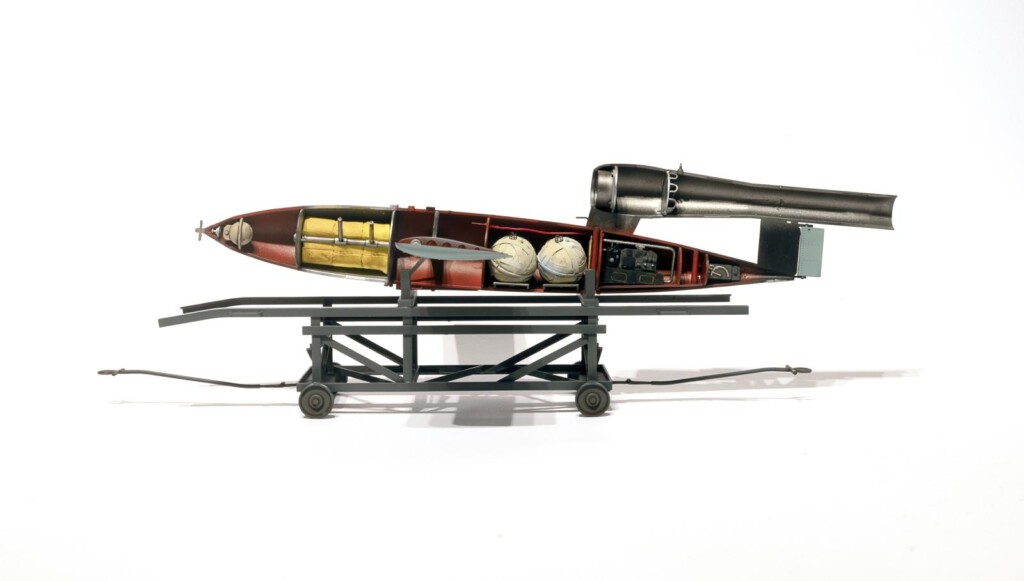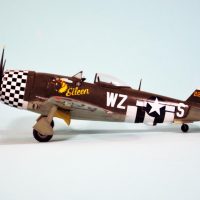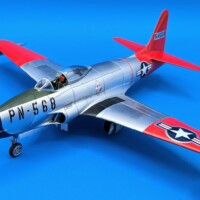Doodlebug! Takom 1/35 V1 Flying Bomb
In 1939 the families of London were given the option of sending their children to the country to avoid predicted raids by Luftwaffe bombers. Many returned before the Blitz when 'the phoney war' played out as a hiatus before the conflict began in earnest. As the Battle of Britain took place the bombing of London began, and my mother and her brother were evacuated from London during the Blitz in 1940, in their early teens. While the photo below (Imperial war Museum) doesn't show them, they would have looked very similar to the children pictured. The British government called this evacuation 'Operation Pied Piper'.
They went to Wales on a train, leaving their parents behind and were welcomed by two families. They hated the experience as they were separated and far from their parents. They often ran away. As the intense period of the Blitz ended in mid-1941 they returned and settled again into London life among the ruins.
In 1944 a new 'Terror' or 'Vengeance' weapon was used on London. My father had by then left in the merchant navy to be part of the supply of the war effort by sea, despite being underage. My mother and her brother remained, living with my grandparents. Many years later, they sometimes spoke to me about their fear of the 'doodlebug', and since then it has been something that has always been of interest to me from a 'family history' perspective. They described the panic that spread when the engine of a V1 rocket cut out. They lived approximately three and a half miles from the site of the first V1 impact, and lived very much in the part of London that was most impacted by these weapons. By this time my mother and her younger brother were older teens and the decision was made to stay with family. As such they lived for approximately a year in the shadow of the V-weapons, launched mainly from France.
In 2018, Stephen Evans and Keith Delaney published a paper in the Journal of Applied Geography, charting the areas that were hit by V1s in London. I have used this picture from their paper and added the abstract which summarises what they found. I dropped a 'red dot' onto their map to show the approximate location of both of my grandparents' houses.
When I saw that Takom produced a 1/35 'cutaway' model of the V1, I immediately decided to build it as part of @lgardner Louis Gardner's group "Imperial German Air Service / Luftwaffe Group Build May 1st, 1910, to Present Day", which currently sits with an impressive membership of 99!
Many references exist to show a number of variations of the interior contents of the V1.
I began the model with the intention of using the clear parts included to show the cutaway, but decided against them eventually because they would make photography too difficult, and I felt that a decent sectioning of the model could be achieved without them, given that the cutaway wing could still sit on the spar. I added Tamiya thin tape to model the wire-wound element of the oxygen bottles, and put in a few wires to represent piping. The 'amtol' explosive in the warhead was made of yellow plasticine dulled down with a sand wash.
I had seen a variety of different diagrams of the rear portion of the interior, so never felt too much guilt about raiding the spares box to the make those areas a little busier!
I don't have too many complaints about the kit, it needs only basic construction skills and fits very well. The only gripe would be about the stencil decals that were a bit thick and still aren't quite fully buried under the dull coat despite the usual use of microsol/set. I used SMS paints, lacquer acrylics made in Aus, that spray very well from the bottle, much like MRP.
Having seen me building this kit, and researching the Blitz and the V-weapons, my two sons bought me a V2 (again Takom 1/35) for my birthday. So I'll build that and some of the Luftwaffe Blitz planes to continue this as a small subset of the group.
Until then then thanks again to Louis for hosting the group.
Finally, to fill in the historical and technical gaps in my write up, here is a video by the Imperial War Museum, London, which illustrates how the V1 worked; its impact in London and Antwerp; how London defences stopped some of these bombs; and its tragic impact on the holocaust. It is not easy viewing at times.
https://www.youtube.com/watch?v=VSD7vpHKUxA
Thanks for looking!



















A superlative build, Paul and a fantastic write-up!
Congratulations!
Thanks so much Spiros, it's a fun build close to my heart for the reasons mentioned.
Absolutely amazing result, Paul @yellow10. This build clearly shows your modelling skills. The article is very informative, thanks for sharing.
Thanks John, plasticine and tape made it a little more like a school project!
Very nice work and a superb result, @yellow10.
Here is some interesting information on V1 targeting, from my coming "bookazine" I did for Key Publishing on the Tempest:
Following the first explosion at Bethnal Green, the attacks on London continued for the next three months, until the Allied armies captured the launch sites in northern France. Prime Minister Churchill announced a month after the campaign began that, “Between 100 and 150 flying bombs, each weighing about a ton, are being discharged daily. The casualties are almost exactly one person per bomb.”
The Times reported in July that, “... not a pane of glass remained in the city buses and thousands of houses were smashed.” The peak of the assault came Aug. 3, when 316 missiles were launched, 220 getting to London. One narrowly missed Buckingham Palace, striking a tall ash tree on the grounds and exploding before reaching the ground, blowing out a number of windows in the royal residence.
Over the course of the summer an average 100 V1s were fired every day at targets in southeast England. A total of 9521 were fired, with the daily number decreasing as sites were overrun until October 1944, when the last V1 site in range of Britain was overrun by Allied forces. More than 1000 crashed on takeoff and almost half were shot down by the British defenses. Many landed far afield and only a quarter of them struck anywhere in London. That amounted to 2419 that hit the city in what was called “The Battle of London,” killing 6184 and injuring 17981, with the greatest number of hits in Croydon, on the south-east fringe of London.
The magnetic compass was located just to the rear of the warhead, inside a wooden sphere. Just before launch, the missile was suspended inside the Compass Swinging Building (Richthaus), where the compass was corrected for magnetic variance and magnetic deviation. The RLM initially planned to use a radio control guidance system for precision attacks against military targets, but Hitler decided to use the missile against London for non-precision “vengeance” attacks.
Rather than radio control, a simple system using an odometer driven by a vane anemometer on the nose determined when the target had been reached, which was accurate enough for the kind of area bombing proposed. Before launch, the odometer was set to count backwards from a number set in according to the prevailing wind conditions that would reach zero upon arrival at the target. During the flight, airflow turned the propeller; every 30 rotations counted down one number on the odometer. The odometer armed the warhead after flying approximately 37mi from the launch site. When the count reached zero, two detonating bolts were fired. Linkage between the elevator and servo was jammed, and a guillotine device cut off the control hoses to the rudder servo, setting the rudder in neutral. This put the missile into a steep dive, which stopped the fuel flow and shut down the engine. The sudden silence alerted listeners on the ground to the impending impact. Initially, the Fi-103's accuracy was within a circle 19mi in diameter; by the end of the war, accuracy had improved to about seven miles, comparable to the V2 rocket.
Once the attacks began, the Germans needed to know where the missiles were hitting, in order to adjust and correct settings in the guidance system. German intelligence requested this information from their agents in Britain on 16 June. However, all German agents in Britain had been turned, and were acting as double agents under British control. If they were given this data, the Germans would be able to correct any shortfall. Since the impacts would be common knowledge and reported in the press, which the Germans had access to through the neutral nations, the Twenty Committee that controlled the agents determined on 18 June that since accurate information would inevitably get through to Germany the double agents would report the V1 damage fairly accurately and minimise the effect on civilian morale. It was also decided that Agent Garbo (Juan Pujol) should mostly report those which hit in the northwest of London, to give the Germans the idea they were overshooting the target area.
Unfortunately, Ostro, an Abwehr agent in Lisbon who pretended he had agents reporting from London, told the Germans London had been devastated and been mostly evacuated as a result of enormous casualties. Since the Luftwaffe could not fly aerial reconnaissance to London, the Germans believed Ostro’s fictional impact and damage reports in preference to Pujol's.
At first, the policy of diverting V1 impacts away from central London was controversial. Churchill was away at a conference at the time and the War Cabinet refused to authorise a measure that increased casualties anywhere, even when casualties elsewhere were reduced by greater amounts. Any delay in starting the reports to Germans might be fatal to the deception. Sir Findlater Stewart, Director of Home Defence Executive took responsibility and ordered the deception programme begin immediately; Churchill approved the decision when he returned
Approximately 200 V1s were fitted with radio transmitters, which clearly demonstrated the V1's tendency to fall short. Oberst Max Wachtel, commander of Flak Regiment 155 (W), the unit responsible for the V1 offensive, compared the data from the transmitters with the reports sent by the double agents. Faced with the discrepancy between the two sets of data, Oberst Wachtel concluded the radio transmitters were faulty, since he had been assured of the agents’ reliability. If Wachtel had disregarded the agents' reports and relied on the radio data, he would have made the correct adjustments to the V1's guidance, with resulting casualties increasing by 50 percent or more.
Fantastic information, Tom! Thanks so much. The map above illustrates your detail about Croydon which is pretty much exactly where the two adjoining red squares fall, south of the river. For the eagle-eyed there is a radio transmitter from a Fieseler Storch hidden in the rear.
That looks fantastic, Paul. Makes me want to get one on the bench soon. Well done!
Thanks Gary. I could see one of your trademark vignette/dios using this kit!
Good work Paul. I’m glad you covered this . The V weapons were a sinister development.
I have a post on the V-2 that complements your article.
My Mom talked about the V-1. When she was at school in Brussels, running for shelter hoping the motor would keep running on the V-1 . When the roar stopped and you could hear that, you were very close to the impact site.
She made it !
Hi Bernard! @bernardbedeur I think our builds should be linked - they complement each other nicely. Your references to Antwerp and other targets are part of this bigger story. I hope you don’t mind if I add a link to your V2 here!
https://imodeler.com/2022/01/the-v-weapons-and-a-vintage-revell-kit-of-1972-2/
Great write-up, Paul, it’s amazing how many people were affected by this, my cousins were evacuated to Dorset by the German threat, and ended up being taught by my father, even though they didn’t know who he was. I was brought up in the 1950s and the damage done by the Germans to our towns and cities was all too evident. It’s difficult to believe there is another war happening in Europe at present, will we never learn?
Thanks George. The IWM photo (above) of the children on the platform shows a group on their way to Devon. For those unfamiliar with the southwest coast of England Devon is a county that borders Dorset to its west.
A great history lesson, I hadn't realized the number of these things that hit the UK! Nice work on the cutaway!
Thank you Robert, yes even after listening to my family speak of the doodlebugs I was surprised at the volume of attacks and the havoc they wreaked. Then learning that as the allied forces moved through Europe, Hitler switched targets, to Antwerp in particular, as Belgium was liberated, also came as a shock.
Excellent model. I am always surprised that the basic design of cruise missiles hasn't changed much since the V-1 (although the technology has far surpassed it.)
Like the background/family history, too.
Thanks Dan. It was only during the reading around this that I realised they were ‘cruise’ missiles and learned that definition!
Great build, great post! Thank you for sharing.
Thank you DJ!
Paul, @yellow10
This is an amazing build. I enjoyed watching you work your magic during the build thread at our Luftwaffe group build. But what takes it up another notch or two is your personal family connection with this. Some will do evil things to force their own will upon others. Those who fail to learn history will indeed repeat it.
Thankfully we ended up on the wining side this time. In the future we might not be so fortunate. Lets pray this never happens to us again, but it could. My family was very fortunate to live in the USA, where we were out of the range of these "Vengeance" weapons. So we never had to experience the hell that your family went through.
However we did send our sons over to fight for what was right. My family also suffered losses, losing various members in this War. Two of them were never sent home, with one still buried in Florence, Italy, and the other was never recovered at sea near the Philippines when his B-25 crashed into the ocean, the Sulu Sea to be more specific.
One group of 4 Gardner brothers were also badly affected during the liberation of Europe, in circumstances very similar to the movie "Saving Private Ryan". The last brother was seriously wounded at Bastogne and eventually returned home, although he was never the same again. He was shot by a German sniper twice, and wounded by mortar fragments. Once it got dark, somehow he managed to crawl back to the aid station.
Freedom is not free. If we try to fool ourselves into thinking otherwise, all one has to do is stop by any of the VA hospitals. There you will see the true price of freedom, and it's not pretty.
However, if we take a look anywhere in today's world where there's a current conflict happening, (and there's more than one), we can see history repeating itself with innocent civilians being injured or killed daily. I'm afraid that we as a society will never learn.
Thanks @lgardner , I think many of us are of a certain age: born with the war still very much in our parents recent memory as children or participants. It still takes huge bravery and selflessness to go willingly to fight, even against tyrants, when the justness of the cause is not in dispute.